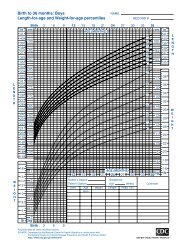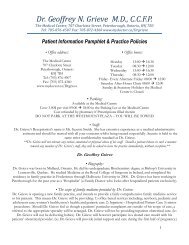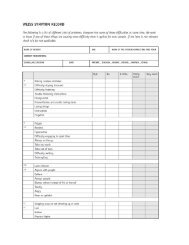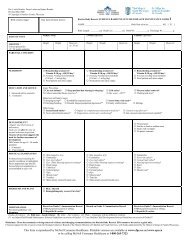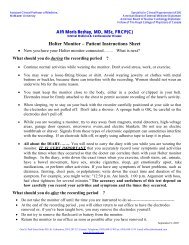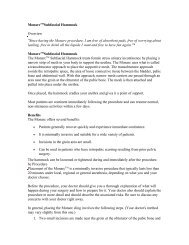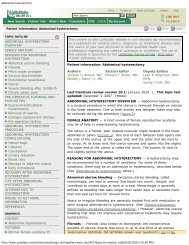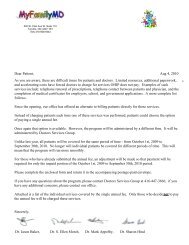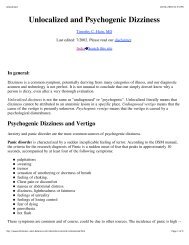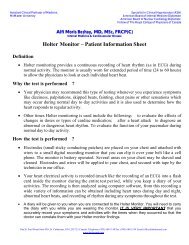Dyslexia (Specific Reading Disability) - Mydoctor.ca
Dyslexia (Specific Reading Disability) - Mydoctor.ca
Dyslexia (Specific Reading Disability) - Mydoctor.ca
Create successful ePaper yourself
Turn your PDF publications into a flip-book with our unique Google optimized e-Paper software.
language-cognitiondyslexiawith spelling checkers, tape recorders in the classroom,recorded books (materials are available from Recordingfor the Blind and Dyslexic, www.rfbd.org), access tosyllabi and lecture notes, use of tutors to “talk through”and review the content of reading material, alternativesto multiple-choice tests (eg, reports or orally administeredtests), and a separate quiet room for taking tests.With such accommodations, many students who havedyslexia now are completing studies successfully in arange of disciplines, including medicine. It is importantto appreciate that phonologic difficulties in dyslexia areindependent of intelligence. Consequently, many highlyintelligent boys and girls have reading problems thatoften are overlooked and even ascribed to “lack of motivation.”When counseling patients who have dyslexia,pediatricians should bear in mind that at least two Nobellaureates, Niels Bohr and Barry Bennacerraf, were dyslexic.People who have dyslexia and their families frequentlyconsult their physicians about unconventional approachesto the remediation of reading difficulties. Ingeneral, very few credible data support the claims madefor these treatments (eg, optometric training, medi<strong>ca</strong>tionfor vestibular dysfunction, chiropractic manipulation,and dietary supplementation). Finally, pediatriciansshould be aware that no one “magic” program remediatesreading difficulties; a number of programs followingthe guidelines provided earlier have proven to be highlyeffective in teaching struggling children to read.Suggested <strong>Reading</strong>Francis DJ, Shaywitz SE, Stuebing KK, Shaywitz BA, Fletcher JM.Developmental lag versus deficit models of reading disability: alongitudinal, individual growth curves analysis. J Educ Psychol.1996;88:3–17Report of the National <strong>Reading</strong> Panel. Teaching Children to Read:An Evidence Based Assessment of the Scientific Research Literatureon <strong>Reading</strong> and its Impli<strong>ca</strong>tions for <strong>Reading</strong> Instruction.NIH Pub. No. 00-4754. Washington, DC: US Department ofHealth and Human Services, Public Health Service, NationalInstitutes of Health, National Institute of Child Health andHuman Development; 2000Shaywitz S. Current concepts: dyslexia. N Engl J Med. 1998;338:307–312Shaywitz S. Overcoming <strong>Dyslexia</strong>: A New and Complete Science-Based Program for <strong>Reading</strong> Problems at Any Level. New York,NY: Alfred A. Knopf; 2003Shaywitz SE. <strong>Dyslexia</strong>. Scientific Ameri<strong>ca</strong>n. 1996;275:98–104Shaywitz SE, Fletcher JM, Holahan JM, et al. Persistence of dyslexia:The Connecticut Longitudinal Study at Adolescence.Pediatrics. 1999;104:1351–1359Shaywitz SE, Shaywitz BA, Fletcher JM, Escobar MD. Prevalenceof reading disability in boys and girls: results of the ConnecticutLongitudinal Study. JAMA. 1990;264:998–1002Shaywitz SE, Shaywitz BA, Pugh KR, et al. Functional disruption inthe organization of the brain for reading in dyslexia. Proc NatlA<strong>ca</strong>d Sci USA. 1998;95:2636–2641Woodcock RW, McGrew KS, Mather N. Woodcock-Johnson III.Itas<strong>ca</strong>, Ill: Riverside; 2001152 Pediatrics in Review Vol.24 No.5 May 2003





